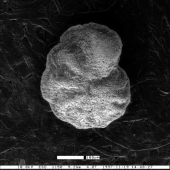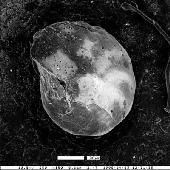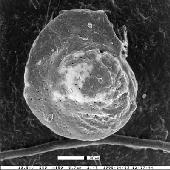|
 See More Images See More Images

Anomalina popenoei
© 1999 UCMP

Cibicides felix
© 2004 University of California Museum of Paleontology

Cibicides fortunatus
© 2004 Karen Wetmore, University of California Museum of Paleontology
|
What are Foraminifera? Foraminifera, often simply called “forams,” are unicellular protists with shells made of organic material, sediment grains, or calcium carbonate. Forams can be found in just about every marine environment from the deep sea to shallow reefs, buried in sediment or floating in the water column. Carbonate beach sand in the tropics is often full of foram skeletons (tests). Forams recovered from drill cores help paleontologists determine the ages of sediment and rock below the surface. Because different species can be found in different environments, their fossil tests are also important for interpreting past environments. First known fossil occurrence: Cambrian. Last known fossil occurrence: Quaternary. This group has living relatives. |
Fossils through time:
Choose a time period to see what life was like:
|
|